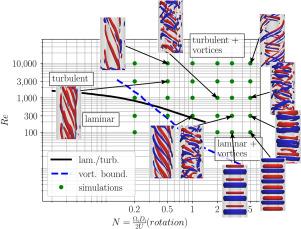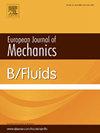Turbulent spiral flow of power-law fluid in annular channel
IF 2.5
3区 工程技术
Q2 MECHANICS
引用次数: 0
Abstract
Transient three-dimensional numerical simulations of power-law fluid flow in an annular channel with a diameter ratio of 1/2 were performed. The outcomes of the simulations using the URANS approach were contrasted with the results of the RANS and LES approaches for Newtonian and power-law fluids. It was demonstrated that comparable outcomes to those obtained through LES can be achieved through URANS with a reduced computational cost. It was determined that the RANS approach tends to underestimate turbulent kinetic energy and pressure losses. Parametric studies were conducted using the URANS approach, encompassing a range of Reynolds numbers () between 100 and 10,000, dimensionless rotation rates () values between 0.2 and 5, and power-law indices () between 0.4 and 1. The following flow regimes were identified: (1) flow without vortices; (2) Taylor-type toroidal vortices; (3) Görtler-type continuous spiral vortices swirling around the inner cylinder; and (4) small-scale Görtler-type vortices near both channel walls. The numerical experiments demonstrated that the rotation of the inner cylinder resulted in three notable effects: a reduction in the apparent viscosity within the vicinity of the rotating cylinder, a decline in viscous shear stresses, and the development of Görtler-type vortex structures, which contributed to an increase in energy losses. Additionally, at Reynolds numbers below 300, high rotation led to the formation of Taylor-type vortices and a reduction in pressure losses. The power law fluid requires increased rotation of the inner cylinder to form vortices and transition the flow to turbulent. When the Reynolds number is less than 300, the first mechanism is the dominant factor, resulting in a reduction in pressure loss. At Reynolds numbers of approximately 300, the first two mechanisms are in competition, with the pressure loss dependent on the power law index, . Finally, at Reynolds numbers greater than 300, secondary vortex structures, such as Görtler vortices, become the dominant factor, leading to an increase in pressure loss with rotation.

环形通道中幂律流体的湍流螺旋流动
对直径比为 1/2 的环形通道中的幂律流体流动进行了瞬态三维数值模拟。对牛顿流体和幂律流体采用 URANS 方法与 RANS 和 LES 方法的模拟结果进行了对比。结果表明,采用 URANS 方法可以获得与 LES 方法相当的结果,而且计算成本更低。研究确定,RANS 方法往往会低估湍流动能和压力损失。使用 URANS 方法进行了参数研究,雷诺数 (Re) 范围在 100 到 10,000 之间,无量纲旋转率 (N) 值在 0.2 到 5 之间,幂律指数 (n) 在 0.4 到 1 之间:(1) 无漩涡流动;(2) 泰勒型环形漩涡;(3) 围绕内圆柱体旋转的哥特勒型连续螺旋漩涡;以及 (4) 靠近通道两壁的小尺度哥特勒型漩涡。数值实验表明,内圆筒的旋转产生了三个显著的影响:旋转圆筒附近的表观粘度降低、粘性剪切应力减小以及哥特勒型涡旋结构的形成,这有助于增加能量损失。此外,在雷诺数低于 300 时,高旋转导致形成泰勒型漩涡,减少了压力损失。幂律流体需要增加内筒的旋转,以形成涡流并使流动过渡到湍流。当雷诺数小于 300 时,第一种机制是主导因素,导致压力损失减少。最后,当雷诺数大于 300 时,次级涡旋结构(如哥特勒涡旋)成为主导因素,导致压力损失随旋转而增加。
本文章由计算机程序翻译,如有差异,请以英文原文为准。
求助全文
约1分钟内获得全文
求助全文
来源期刊
CiteScore
5.90
自引率
3.80%
发文量
127
审稿时长
58 days
期刊介绍:
The European Journal of Mechanics - B/Fluids publishes papers in all fields of fluid mechanics. Although investigations in well-established areas are within the scope of the journal, recent developments and innovative ideas are particularly welcome. Theoretical, computational and experimental papers are equally welcome. Mathematical methods, be they deterministic or stochastic, analytical or numerical, will be accepted provided they serve to clarify some identifiable problems in fluid mechanics, and provided the significance of results is explained. Similarly, experimental papers must add physical insight in to the understanding of fluid mechanics.

 求助内容:
求助内容: 应助结果提醒方式:
应助结果提醒方式:


